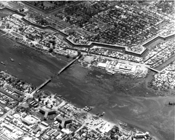- Exhibits
- Tet Offensive
- Hue
- The Aftermath
The Tet Offensive (Tết Mậu Thân)
- The Tet Offensive (Tết Mậu Thân)
- Hue: The Imperial City
- The Battle of Khe Sanh
- The Battle for Saigon
- Aftermath of the BattlesPolitical ConsequencesExhibit Credits
The Aftermath

3M-14-1012-68 Third MarDiv Vietnam 24June68 Photog: Nairns Aerial view of Hue City. Defense Dept. Photo ( Marine Corps) mee A801129 2nd caption also by department of Defense (Marine Corps) Hue: Aftermath (June 1968) Bridge still down but much else rebuilt. MACV compond is in lower left corner, Citadel bastions on other side of Perfume River
(Peter Braestrup Collection [va035396])The end of the battle for Hue marked the end of the Tet Offensive. Following the defeat of their country-wide attacks, the PAVN and VC were forced to regroup, to heal, and to plan for the next phase of their war. International media outlets brought the battle for Hue into the homes of people around the world, causing a great deal of consternation about U.S. involvement in Vietnam. American political and military leadership was also forced to regroup and to reexamine the country’s involvement in Southeast Asia. In the United States, those opposed to the war grew in numbers and in strength, pressuring their leaders to leave Vietnam, and those leaders began to listen.
The people of Hue did not possess the luxury of deciding whether or not to remain in the war; the war had come to them and had taken a ghastly toll. Thousands of the city’s inhabitants lay dead at the end of February 1968, and out of the city’s total population of 140,000, an estimated 100,000 citizens were refugees. Basic city services were not available for months. Food, clean water, and medical care were the utmost priority for this damaged city, as was the mourning for those whose lives were taken during the battle. The city that had for years been bypassed by the war was now left to deal with some of the war’s most difficult and heart-rending legacies.
The combatants in the battle for Hue sacrificed, as well, many of whom made the ultimate sacrifice. There is still no firm agreement on the number of combat deaths in Hue. An estimated 5,100 PAVN and VC were killed trying to take the city. Nearly 400 ARVN and over 200 US Marines lost their lives in stopping them. Regardless of one’s personal views of the war, of the battle, or of the war’s legacies, we must take time to pause and reflect upon those events, and especially about the heroic efforts of those who fought, sacrificed, and died in Hue.
Vietnam Center & Sam Johnson Vietnam Archive
-
Address
Texas Tech University, Box 41041, Lubbock, TX 79409 -
Phone
(806)742-9010 -
Email
vnca@ttu.edu

